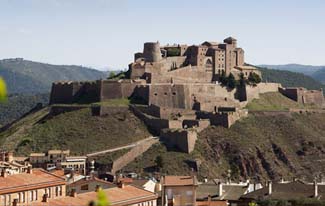
Photos courtesy of Parador de Cardona
08261 Cardona
(Barcelona)
Tel: ++34 938 69 12 75
Fax: ++34 938 69 16 36
Official parador website
Reserve with Booking.com
49 rooms
Double rooms: 95–140 euros
Rates include tax.
Free Wi-Fi
Open: beginning March through mid-January
Cardona is 97 km northwest of Barcelona on C-1410. A car is the best means to get there.
Nearby: horseback riding; golf; fishing; canoeing; walking tours through old quarter of Cardona; salt museum; Montserrat monastery
In this meticulously cared for parador, you’ll find red tile floors shined to a high gloss, wood beams covering arched ceilings, heraldic tapestries and wrought-iron torches decorating the walls, and many Catalan antiques filling the rooms.
An elevator carries you to six floors of guest rooms. Many have canopy beds, hand-painted headboards, and woven bedspreads. Room 712 is reputed to be haunted by a ghost dressed in a leotard and period costume. (When the castle underwent restoration, a security dog stood outside the room and barked almost nonstop for over a month.)
The restaurant is situated in an ancient stone vaulted room. The menu offers typical Catalan dishes such as salmon in red pepper sauce and wild boar with chocolate. Wild mushrooms and stews are a specialty as well.
![]() Cardona is a Spanish National Monument, with its Gothic court and chapel now preserved as a museum.
Cardona is a Spanish National Monument, with its Gothic court and chapel now preserved as a museum.